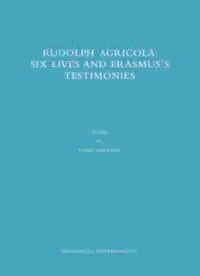
Rudolph Agricola: Six Lives and Erasmus's Testimonies PDF
Preview Rudolph Agricola: Six Lives and Erasmus's Testimonies
Rudolph AgRicolA: six lives And eRAsmus’s testimonies bibliotheca latinitatis novae editors Jan Waszink ● Yasmin haskell ● david money corinna vermeulen ● Wouter Kool Advisory Board Fokke Akkerman ● maurizio campanelli ● Karl enenkel ● philip Ford chris heesakkers ● Ann moss ● Andreas Kinneging ● christoph pieper marianne pade ● dirk sacré ● Yvonne twisk www.bln-series.eu BLN aims to make available a wide range of Latin texts from the Renaissance and early modern period. The series serves Latinists as well as modern linguists, Renaissance and early modern historians, historians of art, science and law, and all other students of the classical tradition. Rudolph AgRicolA: six lives And eRAsmus’s testimonies edited, translated and annotated by Fokke Akkerman english translations by rudy bremer and corrie ooms beck royal van gorcum 2012 © 2012 Koninklijke van gorcum Bv, po Box 43, 9400 AA Assen, the netherlands All rights reserved. no part of this publication may be reproduced, stored in a retrieval system, or transmitted, in any form or by any means, electronic, mechanical, photocopying, recording, or otherwise, without the prior permission of the publisher. isBn 978 90 232 5072 2 printed in the netherlands by Royal van gorcum, Assen 2011144 [Akkerman] 00-Prelims-proof-03 [date 1207200658 : version 1202211330] page -5 CONTENTS List of Illustrations vii Preface ix Introduction: The Life of Rudolph Agricola Summary A Chronological Discussion of the Information found in the Letters, the Vitae and the Archives Some Remarks about this Edition Sources and Sigla of the Texts The Vitae: Introductions, Texts and Translations Johannes Trithemius Johann von Plieningen Goswinus van Halen Gerard Geldenhouwer Philippus Melanchthon Letter to Alardus of Amsterdam Academic Oration. The Life of Rudolph Agricola Notes to the Texts Erasmus on Agricola Bibliography Index Nominum v 2011144 [Akkerman] 00-Prelims-proof-03 [date 1207200658 : version 1202211330] page -6 2011144 [Akkerman] 00-Prelims-proof-03 [date 1207200658 : version 1202211330] page -7 LIST OF ILLUSTRATIONS Portrait of Rudolph Agricola Aduard, Reconstruction Drawing of the Cistercian Abbey Sanctus Bernardus, founded in Letter from Ludolph and Adam van den Bergh to their Father Willem Castle “Huis Bergh”, ’s-Heerenberg A Sample of Writing and Illumination from the Convent of Selwerd, ca. Musician with Trumpet in s-shape. Fresco on a Vault of St. Martin’s in Groningen, ca. vii 2011144 [Akkerman] 00-Prelims-proof-03 [date 1207200658 : version 1202211330] page -8 2011144 [Akkerman] 00-Prelims-proof-03 [date 1207200658 : version 1202211330] page -9 PREFACE My involvement with the vitae of Rudolph Agricola dates from the early s, when preparations were made in Groningen to honor its son, the humanist Agricola, with a conference in memory of the th anniversary of his death on October , . At that time I first translated the texts of the vitae into Dutch; then, still before our conference (October –, ), I had them translated into English by Dr. Rudy Bremer. He and I discussed the various difficulties that arose in that process; the greatest problem was the fact that critical editions, translations, bibliographies, and detailed studies of Agricola and his texts were practically non- existent. This formed a sharp contrast with the great fame Agricola enjoyed among his contemporaries and the generations of humanists after him – and even during all the years up to our own time: when Arjo Vanderjagt and I announced the conference in a few scholarly journals, we received enthusiastic reactions from all over the world! During the conference it became evident that the lack of primary material was a source of regret to the participants as well, and together we discussed possible ways of improving the situation. The imperfect transmission of the texts also caused great problems in editing the conference proceedings because no consistent reference methods had been used; therefore we added two extensive lists of primary and secondary literature to our Acta (rap ), adhering to consistent guidelines. Earlier, in , a scholarly bibliography of the old sources of Agricola’s texts had already been published by Gerda Huisman. Now, years later, we are happy to say that the situation has greatly improved. For recent editions of the texts written by Agricola, see the Bibliography under Agricola. Of the vitae, the one by Johann von Plieningen (edited byWerner Straube with a German translation and commentary) was published in the Kühlman collection of . Today, in , this book offers the texts (with an English translation and notes) of all of the six vitae, written by Agricola’s contemporaries or by humanists of the next generation who were still in close contact with Agricola’s contemporaries. Not only are these vitae of great importance to our knowledge of Agricola’s life, but they also offer us some fine examples of early humanist writing and composition technique along with a colorful selection of facts and fiction; these in themselves make the vitae a delight to read. These vitae are, of course, no biographies in a modern sense; rather, they give the impression of secularized hagiographies. Similarly, Agricola did not write his letters with the intention of offering future readers a connected account of his life. As a source of knowledge for Agricola’s life the vitae are a counterpart to the ix
